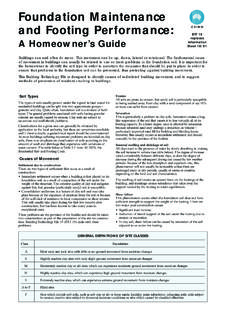Transcription of Construction and Operating Costs of Groundwater ... - CSIRO
1 Construction and Operating Costs of Groundwater pumps for Irrigation in the Riverine Plain D. W. Robinson Technical Report 20/02, January 2002 2002 CSIRO To the extent permitted by law, all rights are reserved and no part of this publication covered by copyright may be reproduced or copied in any form or by any means except with the written permission of CSIRO Land and Water. Important Disclaimer CSIRO Land and Water advises that the information contained in this publication comprises general statements based on scientific research. The reader is advised and needs to be aware that such information may be incomplete or unable to be used in any specific situation.
2 No reliance or actions must therefore be made on that information without seeking prior expert professional, scientific and technical advice. To the extent permitted by law, CSIRO Land and Water (including its employees and consultants) excludes all liability to any person for any consequences, including but not limited to all losses, damages, Costs , expenses and any other compensation, arising directly or indirectly from using this publication (in part or in whole) and any information or material contained in it. Cover Photograph: Where Bore on Ray Zanatta's Denimein farm Photograph by Liz Humphreys 2002 CSIRO (i) Acknowledgements The author wishes to acknowledge Terry Hunter of Goulburn Murray Water (Tatura) and Heinz Kleindienst of Sinclair Knight Merz (Tatura) for supplying shallow Groundwater pumping system (spearpoint) Costs .
3 Many thanks are also due to Rex Watson of Watson Drilling (Deniliquin), Brian Cockayne of Combined Agricultural Machinery (Deniliquin) and Joe Catanzariti of Quiprite (Griffith) for supplying capital and installation Costs for bores, pumps and motors. The author also appreciates the information supplied by G. Toscan of Murrumbidgee Groundwater Pumpers Association. (iii) Executive Summary The use of Groundwater as a water source for irrigation is increasing as surface water supplies are becoming fully utilised and increasing in value which has made the pumping of Groundwater an attractive alternative.
4 This report provides a summary of the installation, capital and Operating Costs of Groundwater pumping systems for irrigation and salinity control. Essentially there are two types of Groundwater pumping systems used for the purpose of irrigation - bores and spearpoint. Bores are used to pump Groundwater from aquifers to supplement surface water supplies whereas spearpoint systems pump Groundwater from shallow watertables and are mainly used for salinity and waterlogging control but can also supplement irrigation supply depending on the quality of the Groundwater .
5 The implementation of a Groundwater pumping system by farmers will ultimately depend on its financial viability. The cost of setting up a pumping system can vary significantly between farms depending on the bore's intended purpose, hydrological conditions, Groundwater quality, location to electrical power and disposal options. The siting, design, materials and Construction method used in installing a bore are other factors that also influence cost but also have an impact on the quantity and quality of water obtained. The capital cost of purchasing and installing a spearpoint system to pump a shallow watertable can vary from approximately $18,000 to $70,000.
6 The high range can be attributed to the variability of spearpoint design, pumping capacity, depth of wellpoints, engine type, proximity to electric power and water discharge area and the cost of a geo-technical investigation. The capital cost of purchasing and installing a shallow bore is variable with a range similar to spearpoint systems. A deep bore will range from approximately $90,000 to $320,000. The capital cost of purchasing and installing a bore will vary depending on pumping capacity, bore depth, system design, materials used, engine type, proximity to electric power and water discharge area.
7 The major cost components of a bore are drilling (including test hole), bore casing and screens, bore development, pump, motor, power connection and installation Costs . The variable or running Costs of Groundwater pumping systems includes power Costs , maintenance Costs on the pump and motor and depreciation. The running Costs of an electric powered pumping system is less than a diesel powered system because of lower power and maintenance Costs . Power line extension is expensive therefore if power connection Costs are relatively low compared to the total capital cost of the pumping system, an electric powered pumping system is more cost efficient than a diesel powered system to pump Groundwater .
8 Before installing a Groundwater pumping system it is advisable that a financial feasibility study is undertaken to assess whether a Groundwater pump is a viable and worthy investment over a time frame equivalent to the effective life of the investment. The analysis should include a comparison of the different pumping system designs and alternative power sources available to determine which pumping design is the most cost efficient over its effective life. Table of Contents Acknowledgements .. i Executive Summary .. iii 1 Introduction .. 1 2 Types of Groundwater 3 Groundwater Pumping Systems.
9 4 4 Bore .. 5 Shallow 5 Deep bore .. 6 4 Capital cost of Groundwater 7 Spearpoint Systems .. 7 10 5 Variable Costs of Groundwater pumps .. 14 Electric Powered 14 Diesel Powered 15 Calculation of a Pump's Energy Requirements .. 15 6 Comparing the Capital and Running Costs of a Pumping 18 7 Conclusions .. 19 8 References .. 20 APPENDIX 1 Spearpoint Systems - Case 21 APPENDIX 2 Private Spearpoint Costs For The 22 APPENDIX 3 Example of Spearpoint Costs from Murray Irrigation .. 23 APPENDIX 4 Total cost of Public Salinity Control pumps in the SIR.
10 24 APPENDIX 5 Geo-technical Investigation Costs for a Public Groundwater Pump in the 25 APPENDIX 6 Capital Costs of a Public Pump in 27 APPENDIX 7 Bore Costs .. 28 1 1 Introduction Some twenty per cent of Australia's water use is from Groundwater sources (Agriculture and Resource Management Council of Australia and New Zealand, 1997). Agriculture is the main use of Groundwater , which accounts for 88% of total Groundwater use in NSW (Figure 1) (University of NSW Groundwater Centre, 2001).








